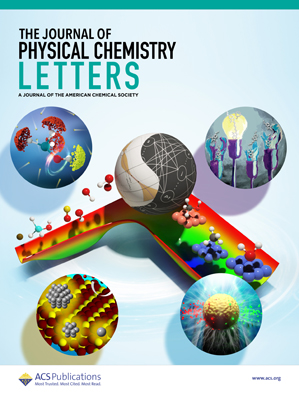可编程原子状纳米颗粒定向自组装成胶体分子
IF 4.6
2区 化学
Q2 CHEMISTRY, PHYSICAL
引用次数: 0
摘要
胶体分子是一种具有分子样结构的新型纳米颗粒簇,可以提高材料的性能,并在纳米技术和材料科学中广泛应用。然而,用精确的、可控的架构构建它们仍然具有挑战性。受化学反应概念的启发,我们从理论上设计了一种由DNA链和聚合物链双功能化的新型纳米颗粒,并提出了一种逐步策略,通过粗粒度分子动力学模拟,将双功能化纳米颗粒的组装分层编程为定义良好的胶体分子。该方法利用聚合物和DNA的协同效应来创建具有各种价域的可编程原子状纳米颗粒。通过精心设计链,这些纳米颗粒被编程共同组装成具有不同对称和配位数的各种胶体分子,这些胶体分子可以通过纳米颗粒的分子设计以及共组装系统的组成设计进行精细调节。我们的策略为将纳米颗粒控制在一起组装成定制的胶体分子提供了一种新的方案,扩展了纳米材料制造技术。本文章由计算机程序翻译,如有差异,请以英文原文为准。

Directional Self-Assembly of Programmable Atom-like Nanoparticles into Colloidal Molecules
Colloidal molecules, novel nanoparticle clusters with molecular-like structures, can enhance material performance and broaden applications in nanotechnology and materials science. However, constructing them with a precise, controllable architecture remains challenging. Inspired by the concepts of chemical reaction, we theoretically design a novel type of nanoparticles bifunctionalized by DNA strands and polymer chains and propose a stepwise strategy to hierarchically program the assembly of bifunctionalized nanoparticles into well-defined colloidal molecules by virtue of coarse-grained molecular dynamics simulations. This method leverages the synergistic effects of polymers and DNA to create programmable atom-like nanoparticles with various valence domains. By carefully designing strands, these nanoparticles are programmed to coassemble into various colloidal molecules with distinct symmetries and coordination numbers, which can be finely tuned by the molecular design of nanoparticles as well as the composition design of the coassembly system. Our strategy provides a novel protocol for the controlled coassembly of nanoparticles into customized colloidal molecules, expanding nanomaterial manufacturing techniques.
求助全文
通过发布文献求助,成功后即可免费获取论文全文。
去求助
来源期刊

The Journal of Physical Chemistry Letters
CHEMISTRY, PHYSICAL-NANOSCIENCE & NANOTECHNOLOGY
CiteScore
9.60
自引率
7.00%
发文量
1519
审稿时长
1.6 months
期刊介绍:
The Journal of Physical Chemistry (JPC) Letters is devoted to reporting new and original experimental and theoretical basic research of interest to physical chemists, biophysical chemists, chemical physicists, physicists, material scientists, and engineers. An important criterion for acceptance is that the paper reports a significant scientific advance and/or physical insight such that rapid publication is essential. Two issues of JPC Letters are published each month.
 求助内容:
求助内容: 应助结果提醒方式:
应助结果提醒方式:


